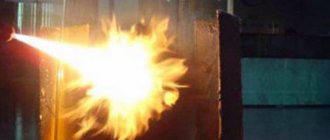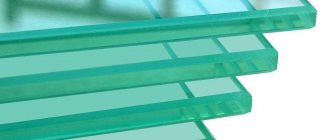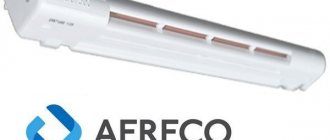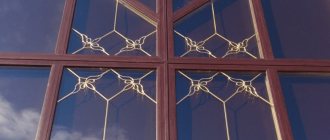Transparency of automobile glazing is useful for ensuring visibility, especially in the dark and in bad weather, but has the disadvantage of free penetration of solar energy with subsequent heating of the interior to an uncomfortable temperature.
Even if the car’s climate system is turned on, then it doesn’t need extra overload, not to mention fuel consumption, and when parked with the engine turned off, such an attack of infrared radiation can turn into a disaster, even leading to the destruction of interior elements.
It is advisable to retain some of the light before it enters the cabin, that is, to darken the windows.
What is an athermal front window
Do not confuse heat-resistant glass with tinting or spraying.
The coating becomes heat-resistant with the application of silver ions. The procedure is possible in services with high-quality equipment. Determal auto glass cannot be made heat-resistant at home. Some cars have athermal auto glass as standard.
Advantages and disadvantages
Athermal windows have their pros and cons.
Advantages of heat-insulating glass:
- Durable and durable anti-reflective coating.
- The coating works on the principle of a thermos: in warm weather it keeps the interior cold, and in winter it keeps it warm.
- Saving gasoline.
- In winter, the windows do not freeze or fog up.
- Ultraviolet and infrared rays are half absorbed by the material.
- Reduces heating of the front of the car and steering wheel.
- The image is not distorted.
- Reduces driver visual fatigue.
- Eliminates thermal deformation of vehicle parts.
Minuses:
- High price. It costs 2 times more than regular material.
- Reduces the performance of radars and other equipment.
- Not available for all car brands.
Are thermal tinting and glass the same thing?
To prevent excess light energy from entering the interior, it is enough to apply a light-absorbing film to the glass. Stick on or even spray on in a vacuum.
Related article: How to apply tint in a car yourself - photo and video instructions
This will give a certain effect, but at the same time a number of disadvantages will arise:
- the strength of such a coating in any case leaves much to be desired, since any film does not have the properties of glass and can be damaged, peel off, or simply become old;
- radiant energy will be absorbed more than reflected, which will lead to its accumulation and ultimately still lead to unwanted heating of the cabin;
- if you increase the reflectivity of the applied surface layer, then such glass will begin to glare, which is unacceptable according to safety requirements;
- Most budget films perform at best evenly across all ranges, infrared (IR), visible and ultraviolet (UV), although the ideal would be to suppress the extreme frequencies of the entire spectrum while maintaining transparency in the visible part.
For these reasons, it is best to introduce substances responsible for reflection and absorption during the glass manufacturing process, distributing them throughout the entire mass of the material, which is what is done in the case of real athermal glasses.
How to produce
Athermal glazing is produced using special equipment. Anti-reflective glasses in pale green or pale blue are marked in the upper right corner with the stamps “Overtinted” or “Tinted”. Markings differ in the percentage of light transmittance: Overtinted transmits 81% of rays, and Tinted 3% less.
Each manufacturer produces glass differently, so they can have different shades: from brownish to purple. Athermal options with chameleon colors have beautiful iridescence and are becoming more and more popular on the market.
About making changes to the design
As I said above, any actions with the car are changes to the design. But not all of them need to be registered with the traffic police. The following are not registered.
- Changes when non-original spare parts or pieces of equipment certified as part of this vehicle are installed on a vehicle. The simplest example: installing non-original wipers. It is enough that the wiper packaging indicates that they have been certified as part of your car.
- Provided in the operating instructions. An equally simple example is installing a radio in a car.
- If the athermal film has been tested as part of your car, as stated in the certificate attached to the film, or the application of tinting is provided for in the operating instructions for your car, then you do not need to register it with the traffic police and it is permitted provided the light transmittance of the window is at least 70%. Otherwise, you need to go all the way to register changes to the design.
Will they issue a fine?
It is highly likely that there will be no fine for unregistered changes. The procedure for proving an offense in this case is quite complicated:
- in full accordance with the law, it is necessary to initiate an administrative investigation,
- collect the necessary evidence,
- then – consideration of the case in court.
No one in the traffic police will waste time on this.
In conclusion, when I have an unbridled desire to experiment with the car, I go to the store and buy new windshield wipers. First of all, it's cheap. Secondly, replacing them yourself is not difficult. And thirdly, I feel a feeling of complete satisfaction from the work I did with my own hands.
Athermal film
If purchasing athermal auto glass is in doubt, install the film. It's cheaper and easier. Athermal windshield tint consists of many layers and does not contain metal. Two layers - film from ultraviolet rays. The main protection against the destructive effects of sunlight lies on the adhesive part of the adhesive layer, polyester, metallized and a special layer against mechanical damage. Tinting also contains substances that reduce the level of exposure to rays in the interior. The colors of athermal film are very different: from pastel blue to rich, bright chameleon.
Advantages of athermal glass tinting:
- Ensuring normal temperature in the car.
- The interior does not heat up.
- Costs less than glass.
- The upholstery does not fade and lasts longer.
- Helps remove glare from car windshields.
- Reduces the risk of parts becoming deformed due to sunlight.
- Protects passengers and the driver from fragments in the event of an accident.
Minuses:
- The driver's eyes get tired quickly.
- The metallized layer interferes with the operation of radar and other similar equipment.
- Attracts the attention of the police.
- If the car's auto glass has decreased throughput, the thermal fluid will exceed the figure required by GOST. This threatens with a fine of 500 rubles.
How to install
To install the tint film, we will need:
- Atermalka is in the right condition. Decide how many glasses you will tint and calculate the required area. Leave some room for customization.
- Spray bottle or any other spray.
- Liquid soap or a product like Fairy and water.
- Blade or knife.
- Felt napkins.
- Forcing or a plastic, non-sharp spatula.
- Scraper for cleaning car windows.
- Construction hairdryer.
Tinting a windshield with athermal film does not require any special skills or dexterity. Let's start with the side windows:
- Making a soap solution. You will need approximately 2 liters. Per liter of water, 5-10 drops of detergent. It’s better to take Fairy: it removes fat more thoroughly. Apply the solution to the outer surface of auto glass.
- Unfold and place the cutout against the window. It is advisable to cut not closely, but with an allowance of several centimeters. The material will immediately adhere to the wet surface, and this will greatly facilitate installation.
- Cut along straight lines. Now open the window slightly. Align the tint along the edge. Trim the curved line.
- On many foreign-made cars, the windows have an uneven shape. We need to adjust the tint to match it. Apply more soap solution to the outside of the window. We apply the material. Smooth out by forcing from the center, after which folds will appear on the surface. We set the temperature to 550 °C on a hair dryer, direct it to the fold and level it by forcing it from the center. You need to stretch the tinting material so as to remove excess air and water. The film is ready in shape.
- Wash the glass thoroughly with a special cleaner. If there are any small particles, scrape them off carefully with a blade. Do not scratch dry glass.
- Let's start gluing. Remove the protective film. Preferably not all of it, but the top half. We wet the adhesive part with a soap solution. We try on the athermal to the window. Let's open it slightly to align the top side. The solution prevents the film from sticking and gives time for adjustments. We remove all excess (air and water bubbles) by forcing, moving from the center to the sides. It is necessary to achieve a tight fit of the film. We lift the glass and do the same with the lower half of the film.
Pros and cons of safety glass
The use of athermal glazing cannot consist of advantages alone; the complexity and imperfection of manufacturing technologies affects it.
It is impossible to create a perfect optical filter around a car.
- The production of athermal glass, even not the most advanced, is expensive, their price is at least twice the cost of regular glass, regardless of whether it is triplex or tempered side and rear glass.
- Despite all efforts, visibility through athermal glass still deteriorates, which necessarily affects traffic safety in low light conditions.
- There is some distortion of the color rendition of the glass, a drawback characteristic of any optical filter.
- Radio communication inside the car becomes difficult. Sensitive devices have to be taken outside of it.
- There may be problems with current legislation if the glass is not certified accordingly.
- The type of shading may not be compatible with driver's sunglasses based on the polarization of the light output.
Moreover, the advantages of such glazing outweigh all its disadvantages.
- The car interior lasts longer in conditions of strong solar radiation; cheaper materials can be used, which would quickly become unusable with ordinary glass.
- Fuel is saved due to a more gentle operating mode of the climate system.
- The car interior does not overheat when parked; it can be cooled down quickly before driving.
- The driver does not have to strain his eyesight, and the likelihood of glare is also reduced due to the softer scattering of the rays.
- When the heater is operating, although slightly, the dissipation of heat by radiation into the surrounding space is reduced.
The advantages of such glazing are so great that many car owners seek to install it on cars where it is not provided by the factory.
Is there a penalty for installation
According to GOST, permitted tinting transmits more than 70% of sunlight without a mirror effect. This means that there is no fine for installing athermal glass on a car if it complies with the law. Only the front side windows and windshield are adjustable. But athermal film, which transmits less than 60% of the light, begins to mirror. This is not allowed on any window.
The fine for incorrect tinting is 1,500 rubles. In case of repeated violation, the amount increases to 5000.
How to distinguish a fake from the original
There is never a limit to the resourcefulness of swindlers, so today some unscrupulous sellers manage to sell even ordinary products with a sun protection strip under the guise of athermal glass. In order not to pay big money for a simple piece of glass, you need to keep your eyes open and pay attention to the following details:
- Marking. The word “Tinted” (light transmission level 81% for windshield and 80% for side windows) or “Overtinted” (78.5% and 72%) must be present on the glass. You also need to pay attention to the fact that “Tinted” products will have a slight greenish tint, while “Overtinted” products have a more saturated green color.
- Price. Athermal glass may not cost as much as regular glass. Considering the complexity of its production, the price should be at least 10-15% higher.
- Glass edge. If the product is made with high quality, then in the form of poor-quality processing of the edges of the product. Therefore, you need to run your hand along the edge. If roughness, unevenness or nicks are felt, then most likely such a speaker was made in artisanal conditions.
There are also two more simple ways to check the product:
- We put on sunglasses with a polarized effect and look at the surface of the glass. If rainbow tints seem to appear on it, like on a puddle of spilled gasoline, then such a product is real.
- We place the glass in the sun so that it creates a shadow. If it is darker than the product itself, then the speaker is real; if it is lighter, then it is clearly a fake.
If we talk about the shade of real glass, it will not necessarily be pure green. The surface may also have a bluish, purple or brownish tint.
Production Features
Many people consider athermal glass to be a tinting method. But I would not say that we are talking about simple glass tinting here. Tinting involves the application of special materials. For example, you can look at previous materials about silicone and removable tinting.
I'll tell you right away. Since the technology is new to many, many often confuse the concept of athermal glass with the application of tinting or with the installation of tinting films. But in the case of speakers, the manufacturing technology is much more complicated. They cannot in any way be applied to a finished windshield. That's why it's not tinted.
What kind of glass is called original?
Vehicle glazing is a visible replacement part and is labeled by vehicle manufacturers with branded logos or wordmarks (such as “TOYOTA”) that are protected by intellectual property rules, the use and distribution of which are restricted.
(!) There are exceptions - if the car has a twin, made on the same platform, but under a different brand, the original glass may not be marked with the name of the factory. Example: Porsche Cayenne - VW Touareg, MMC ASX - Peugeot 3008. A “native” part refers to an OEM (Original Equipment Manufacturer) - this means that the product sold to retail customers is released under the original brand.
According to standards, automakers require dealers and services to use OEM spare parts for warranty repairs. But at the same time, automakers do not limit their partners from selling spare parts under the brand to independent service companies.











